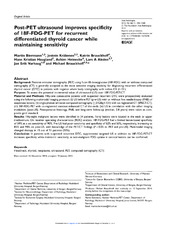| dc.description.abstract | Background: Positron emission tomography (PET) using fluor-18-deoxyglucose (18F-FDG) with or without computed tomography (CT) is generally accepted as the most sensitive imaging modality for diagnosing recurrent differentiated thyroid cancer (DTC) in patients with negative whole body scintigraphy with iodine-131 (I-131). Purpose: To assess the potential incremental value of ultrasound (US) over 18F-FDG-PET-CT. Material and Methods Fifty-one consecutive patients with suspected recurrent DTC were prospectively evaluated using the following multimodal imaging protocol: (i) US before PET (pre-US) with or without fine needle biopsy (FNB) of suspicious lesions; (ii) single photon emission computed tomography (≥3 GBq I-131) with co-registered CT (SPECT-CT); (iii) 18F-FDG-PET with co-registered contrast-enhanced CT of the neck; (iv) US in correlation with the other imaging modalities (post-US). Postoperative histology, FNB, and long-term follow-up (median, 2.8 years) were taken as composite gold standard. Results: Fifty-eight malignant lesions were identified in 34 patients. Forty lesions were located in the neck or upper mediastinum. On receiver operating characteristics (ROC) analysis, 18F-FDG-PET had a limited lesion-based specificity of 59% at a set sensitivity of 90%. Pre-US had poor sensitivity and specificity of 52% and 53%, respectively, increasing to 85% and 94% on post-US, with knowledge of the PET/CT findings (P < 0.05 vs. PET and pre-US). Multimodal imaging changed therapy in 15 out of 51 patients (30%). Conclusion In patients with suspected recurrent DTC, supplemental targeted US in addition to 18F-FDG-PET-CT increases specificity while maintainin sensitivity, as non-malignant FDG uptake in cervical lesions can be confirmed. | en_US |

